Technical data
Overview
Specifications Processor and memory
CPU: Qualcomm Snapdragon 821 @2.35 GHz
GPU: Adreno 530
RAM: 4GB / 6GB
Internal memory: 128GB / 256GB
Memory extension: no
Display
Display diagonal: 6.4 inches
Display resolution: 2048 x 1080 pixels
Display Type: IPS
Multitouch: 10 fingers
Cameras
Main Camera: 16 Megapixel OmniVision OV16880
* Aperture f / 2.0
* Autofocus
* Dual LED flash
Front camera: 5 megapixel
wireless
WiFi: 802.11a / b / g / n / ac
Bluetooth: 4.2
Navigation: GPS / GLONASS / Beidou
NFC: Yes
Sensors
* Brightness sensor
* Accelerometer
*Gyroscope
* E-compass,
*Barometer
* Proximity Sensor
Mobile
SIM: Dual SIM
SIM Type: Nano
networks:
2G: GSM B2/B3/B5/B8
3G: WCDMA B1/B2/B5/B8
4G: FDD-LTE: B1/B2/B3/B4/B5/B7/B8
Battery
Capacity: 4.400 mAh
Quick batch: V3.0
Other
Fingerprint scanner: Yes
Operating System: MIUI 8 (Android 6)
Size: 15.80 x 8.19 x 0.79 cm
Weight: 211g
What's in the box1x Xiaomi Mi Mix
1x USB Type-C cable
1x Charger (Type A Plug)
1x Leather Back Case
1x SIM needle
1x user manual
First impression - Xiaomi Mi Mix
What's in the box
The innovative Xiaomi Mi Mix is delivered in an inconspicuous, black cardboard box with only the words "MIX DESIGNED BY MI" emblazoned on it. But not only the smartphone is included, the scope of delivery also includes a leather back cover, a quick charger with type A plug, a USB type C cable, a SIM needle to open the SIM slot and a Chinese operating manual.
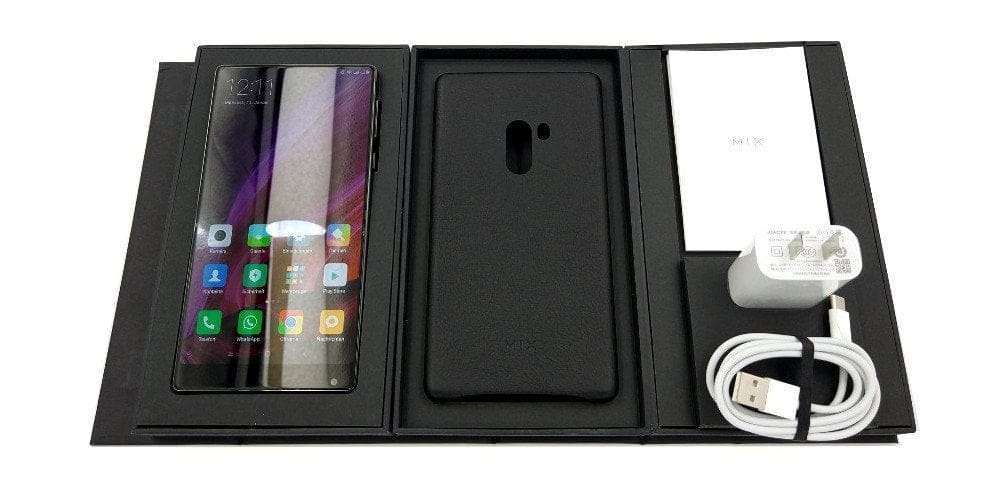
Design and workmanship
When it comes to design, the Mi Mix is unparalleled - you might think - but that's not entirely true. Just a few years ago, Sharp released similar concept smartphones with the Aquos Crystal and Aquos Xx models, which come very close to the design. The rimless Sharp models were unable to establish themselves and the devices were mainly intended for the Japanese market.
All-ceramic housing with advantages and disadvantages
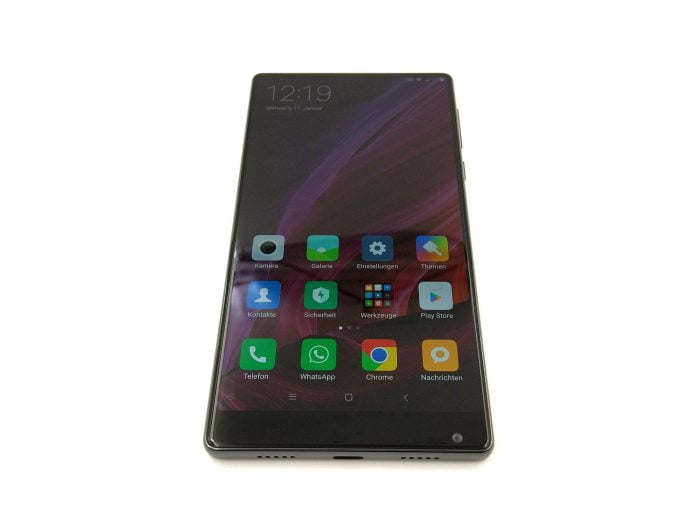
The rimless design of the Xiaomi Mi Mix has received a far greater response. Not only is the front design surprising, the rest of the smartphone's casing is also a real eye-catcher. In collaboration with the French designer Philippe Starck, a smartphone case was created in which all of the components, including the frame and the control buttons, are made of ceramic. Above all, a higher scratch and break resistance are characteristics of ceramics. However, individual fall tests on YouTube show that ceramics are no “egg-laying woolly milk sow”. The frame in particular is prone to breakage.
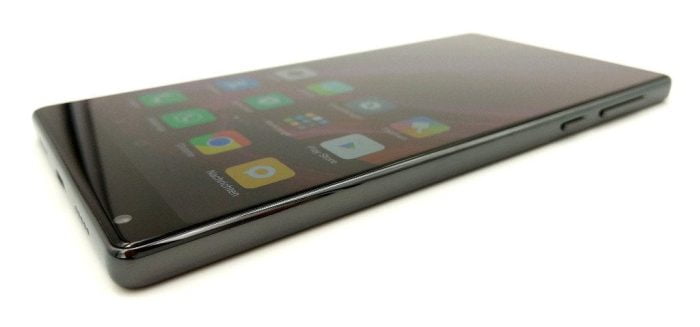
It is also often criticized that the smartphone is slippery in the hand. The slippery feeling is indeed understandable, as a major drawback you can not chalk it to the device. Smartphones with plastic backs are on the same level. Those who handle the device with care will have nothing to fear.
The susceptibility to fingerprints is far more annoying. After unpacking the smartphone and peeling off the protective film on the back, it took less than 5 seconds and the shiny back was covered with unsightly fingerprints. Of course, the enclosed case can help, but the beautiful ceramic case remains hidden.
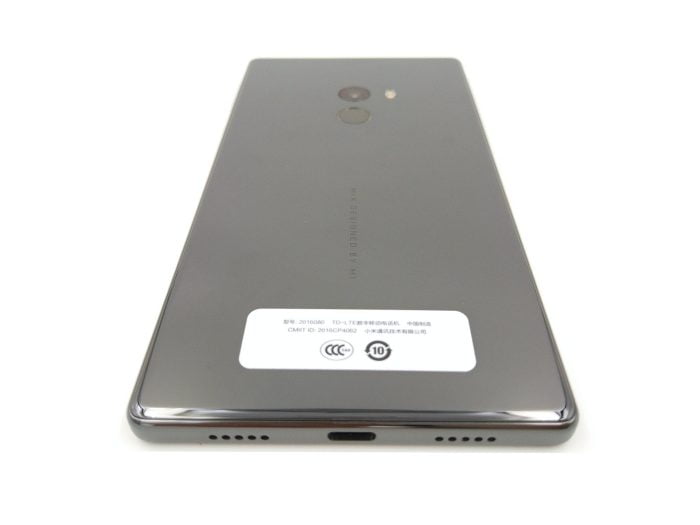
Connections and control buttons
On the underside there is a USB Type-C socket in the middle between the microphone and speaker grilles. A 3.5mm headphone jack is on the opposite side. The SIM card slot is located on the left side of the housing. Opposite are the power button and a volume rocker. The user interface is operated exclusively via the display! A configurable notification LED that shines in different colors is located in the middle below the display.
Processing of the smartphone and accessories
The build quality of the Xiaomi Mi Mix is not to be criticized. The entire smartphone is clean and error-free processed. Also, the included accessories has no defects and delivers the usual Xiaomi processing quality.
Display and acoustic system
The almost borderless, 6.4-inch display is particularly striking. Despite the very high display diagonal, the dimensions of the smartphone are no larger than those of a 5.5-inch iPhone 7 Plus. The Xiaomi Mi Mix achieves the display-to-housing ratio of around 85% by eliminating the entire upper area including the auricle. Xiaomi itself gives a value of 91.3 percent here, but this is not entirely correct. The transition from the display to the edge of the housing is about 2 mm at the top, left and right. The display is also rounded at the corners, which again saves a lot of space and looks damn good.
Because a smartphone without an auricle would be quite nonsensical, Xiaomi has developed a piezoelectric ceramic acoustic system in which the sound is transmitted purely through the housing. The entire housing of the Xiaomi Mi Mix becomes an "auricle".
The display itself has a resolution of 2.040 x 1.080 pixels, which corresponds to a rather unusual aspect ratio of 17: 9. If you now play video material in a 16: 9 ratio, you have unsightly black bars on the left and right. Nonetheless, the display is convincing. With a point density of 362 PPI, the display is razor-sharp. The color display looks lively and can be individually adjusted in the display settings. The maximum display brightness (500 cd / m²) cannot keep up with the Xiaomi Mi5S that we tested a few weeks ago, but it is still within the good average. The same applies to the viewing angle stability.
Multitouch is supported with up to 10 simultaneous inputs. The touchscreen responded accurately and accurately throughout the test phase. Xiaomi is silent to what extent the display is protected by a branded display glass (Corning etc.). But even after more than two weeks of daily use without a screen protector, no scratches were noticeable on the display.
Performance
Like the recently released Xiaomi flagship models, the Mi Mix also uses a Qualcomm Snapdragon 821 processor. The currently fastest Qualcomm SoC available offers 4 Kyro cores that clock with up to 2.35GHz and ensure performance at the highest level. The memory of our copy of the text consists of a 4GB working memory and a 128GB internal memory. There is no provision for memory expansion. The Xiaomi Mi Mix is also optionally available with 6GB of RAM and 256GB of internal storage.
In terms of performance, the device leaves little to be desired. Apps start without delay and even if the memory is “fully loaded” with apps started at the same time, there are no noticeable drops in performance. The Adreno 530 processor graphics of the SoC (System on Chip) can also show its strengths in graphically demanding games and shines with smooth gaming fun.
-

-
AnTuTu
-

-
3DMark
-

-
Geekbench 4
user interface
The Xiaomi Mi Mix uses MIUI 8 based on Android 6. An update to Android 7 Nougat is already being planned and will be released later this year.
Shop ROM vs. China-ROM
Anyone who buys a smartphone has either a so-called “shop ROM” or the official China ROM preinstalled. Unfortunately, a shop ROM was preinstalled on our test copy that we received from Gearbest. For all those who have hardly dealt with flashing a ROM, the shop ROM, compared to the China ROM, also offers a German voice output and has most of the Google services already preinstalled. Probably the biggest disadvantage of a shop ROM is the lack of an update option and the risk of malware.
MIUI 8
All Xiaomi smartphones are equipped with the in-house MIUI user interface. MIUI is far from a pure stock Android and not only offers a completely different look, but also numerous functions. MIUI does without an app drawer. Instead, all apps are stored on the home screen and can be managed in folders. The appearance can be changed again at will via its own theme store. Themes, backgrounds or fonts that have been downloaded from the store can be activated and changed at the push of a button. All the functions of MIUI 8 cannot be accommodated in this review. Overall, the Xiaomi user interface is above all one thing - diverse!
Camera
Now we come to the biggest criticism of this smartphone. At around € 700 you would expect a flagship smartphone with a decent main camera. However, a cheaper 16 megapixel OmniVision OV16880 image sensor with an f / 2.0 aperture was installed, which is also occasionally installed in much cheaper LeTV LeEco models.
main camera
The image and video quality of the main camera is correspondingly disappointing. In really very good lighting conditions, the main camera still produces quite suitable image recordings. The worse the lighting, the stronger the image noise and the overall blurring of the image. The dual LED flash helps with close-up shots, but it could shine a tad brighter. The autofocus of the Xiaomi Mi Mix failed in the test. Although the focus is quick, the smartphone is often wrong with the result. The camera can convince with its accurate color reproduction.
Video recordings are also no joy with the Mi Mix. The video resolutions range from SD to HD and Full HD to 4K. There is no electronic or even optical image stabilization. If you record a video with your smartphone, you get frustrated pretty quickly because of the poor autofocus. With active autofocus, a constant pulsing and refocusing becomes noticeable, which makes even the most cautious video recording unsightly. With manual autofocus, the constant refocusing becomes an ordeal, but the video recordings are quite impressive in good lighting conditions.
Front camera
The 5 megapixel front camera is located below the display. To use the smartphone must be turned upside down. The recording quality, both for picture and video is acceptable in good lighting conditions.
-

-
Good lighting conditions
-

-
Bad lighting conditions
MIUI Camera App
The MIUI Camera app offers a variety of photo modes and photo effects and a manual recording mode, where you can adjust the white balance, the focus, the exposure and the ISO. In contrast to the fully automatic recording, you can use a bit of skill to get the best out of the camera. A nice gimmick is the facial recognition of the app, which allows you to determine the age and gender of the person in the picture. A very useful feature is the detection of QR codes. Overall, the app is well equipped and easy to use.
connectivity
As a dual SIM smartphone, the Mi Mix can be equipped with two nano SIM cards. Both 2G, 3G and 4G network standards are supported. Xiaomi is common, but lacks the LTE band 20, which is coveted in this country, which can result in a waiver of LTE, especially in rural areas.
Telephony
In terms of network quality, there is nothing to complain about with the Mi Mix. The connection to the cellular network is stable and no interference was noticeable during phone calls. What takes some getting used to, however, is the piezoelectric ceramic acoustic system. You can hear the conversation partner a little quieter, as if they were further away. Spoken sound doesn't sound quite as voluminous as through an auricle. Nevertheless, the quality of the call is sufficient to make pleasant phone calls. Conversely, the transmission quality of the smartphone's 3 microphones is excellent.
Wi-Fi and Bluetooth
In addition to the common WLAN standards, the Xiaomi Mi Mix is also compatible with Dual Band WiFi (802.11ac). Bluetooth is supported up to version 4.2. Constant and interference-free wireless transmission is possible with both WiFi and Bluetooth.
NFC, GPS and sensors
The GPS module does an excellent job. A GPS fix takes place within a few seconds and the location inside the building was accurate to within 10 meters. A test navigation went first class and the integrated e-compass also works accurately. In addition to GPS, GLONASS and Beidou are also supported. A location via the European "Galileo" satellite system would be possible with the Qualcomm Snapdragon 821 SoC, but requires an update from Xiaomi.
-
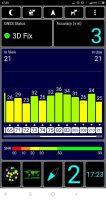
-
GPS outside
-
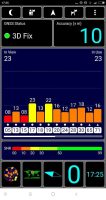
-
GPS inside
NFC works as it should. The existing sensors amount to a brightness sensor, an acceleration sensor, a gyroscope, the already mentioned e-compass, a barometer and a proximity sensor. Because of the rimless design, no infrared proximity sensor was used, but an ultrasonic proximity sensor. The difference is not noticeable in everyday use.
Fingerprint scanner
The fingerprint scanner of the Xiaomi Mi Mix is located on the back and below the main camera. In practice, the fingerprint scanner shines with a high recognition rate and very quick unlocking of the smartphone. The number of finger profiles is limited to a maximum of 5.
Sound
The speaker sounds average. Volume and bass are searched in vain, which creates a flat sound. The maximum volume is sufficient. There is no scratching at maximum volume.
The playback quality via the 3.5mm headphone connection is more promising. Music is played back very clearly and free of noise. The equalizer integrated in MIUI 8, which can be individually adjusted, is also interesting. MIUI 8 even offers different sound profiles for the numerous Xiaomi in-ears, which can be activated at the push of a button.
Battery
A 4.400 mAh battery is built into the Xiaomi Mi Mix, which at first glance appears to be very large. Because of the very large display and the powerful processor, the battery life is only slightly longer than that of other flagship models. If you use your smartphone essentially for WhatsApp or some web browsing, you will achieve runtimes of around 2 days with the Mi Mix. With conventional use, the running time is 1 ½ days. With intensive use, the battery lasted about a day.
With Quick Charge 3.0, the smartphone is charged within a very short time. A full charge takes between 1 ¾ and 2 hours. Half a charge of the battery only takes 45 minutes! There is no unusually high heat generation during charging.